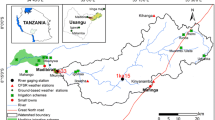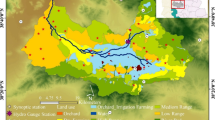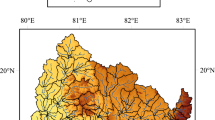Abstract
Landuse landcover (LULC) and climate change have significant hydrological impacts, especially in humid tropical regions. Cautious planning and development based on early preparedness can result in LULC patterns that may improve the well-being of human beings and ecosystem. This demands significant knowledge related to the climatic and hydrological variables. In this study, the impact of future climate and LULC change of a humid tropical catchment Periyar river basin (PRB) in the Western Ghats, India, is investigated using the Soil and Water Assessment Tool (SWAT). The study critically evaluates the individual and combined impacts of LULC and climate change on water balance components including precipitation, surface runoff, evapotranspiration, soil water storage, percolation, base flow, and lateral flow. The future LULC maps are projected to 2030, 2050, 2075, and 2100 using the past data with the help of the Cellular Automata-Markov transition matrix. LULC change indicated an increased urbanization and cropland, whereas a decreased forests and plantations in future. For future climate change impact assessment, ensemble of five global circulation models with RCP 4.5 and RCP 8.5 scenarios is considered. The results suggest climate change impact is dominant over LULC change in the near (2011–2040) and mid (2041–2070) future, whereas vice-versa in the far (2071–2100) future. The quantitative assessment of spatial and temporal variation in hydrological components append insights to the hydrological processes. The results can further add value to studies related to irrigation requirement, groundwater recharge, crop water demand, soil permeability and integrated water resource management. Furthermore, the current modeling framework can be implemented in other humid tropical river basins to understand the hydrological regime changes aiming effective water resources and environmental management.







Similar content being viewed by others
Data availability
The datasets analyzed in the study are available from the corresponding author on request.
References
Abbaspour KC et al (2007) Modelling hydrology and water quality in the pre-alpine/alpine Thur watershed using SWAT. J Hydrol 333(2–4):413–430. https://doi.org/10.1016/j.jhydrol.2006.09.014
Abbaspour KC et al (2015) A continental-scale hydrology and water quality model for Europe: calibration and uncertainty of a high-resolution large-scale SWAT model. J Hydrol 524:733–752. https://doi.org/10.1016/j.jhydrol.2015.03.027
Adam JC et al (2007) Simulation of reservoir influences on annual and seasonal streamflow changes for the Lena, Yenisei, and Ob’ rivers. J Geophys Res Atmos 112(24):1–22. https://doi.org/10.1029/2007JD008525
Adhikari S, Southworth J (2012) Simulating forest cover changes of bannerghatta national park based on a CA-Markov model: a remote sensing approach. Remote Sens 4(10):3215–3243. https://doi.org/10.3390/rs4103215
Aichele SS (2005) Effects of urban land-use change on streamflow and water quality in Oakland County, Michigan, 1970–2003, as inferred from urban gradient and temporal analysis. US Geological Survey Scientific Investigations Report 2005 (5016), p 22. https://doi.org/10.3133/sir20055016
Ammar R et al (2017) Hydrodynamic influence on reservoir sustainability in semi-arid climate: a physicochemical and environmental isotopic study. J Environ Manag 197:571–581. https://doi.org/10.1016/j.jenvman.2017.04.030
Anand J, Gosain AK, Khosa R (2018) Prediction of land use changes based on Land Change Modeler and attribution of changes in the water balance of Ganga basin to land use change using the SWAT model. Sci Total Environ 644:503–519. https://doi.org/10.1016/j.scitotenv.2018.07.017
Arnold JG et al (1998) Large area hydrologic modeling and assessment part I: model development. J Am Water Resour Assoc 34(1):73–89. https://doi.org/10.1111/j.1752-1688.1998.tb05961.x
Bouwer H (2002) Integrated water management for the 21st century: problems and solutions. J Irrig Drain Eng 128(4):193–202. https://doi.org/10.1061/(ASCE)0733-9437(2002)128:4(193)
Chanapathi T, Thatikonda S (2020) Investigating the impact of climate and land-use land cover changes on hydrological predictions over the Krishna river basin under present and future scenarios. Sci Total Environ 721:137736. https://doi.org/10.1016/j.scitotenv.2020.137736
Chang H, Franczyk J (2008) Climate change, land-use change, and floods: toward an integrated assessment. Geogr Compass 2(5):1549–1579. https://doi.org/10.1111/j.1749-8198.2008.00136.x
Chen Q et al (2020) Impacts of climate change and LULC change on runoff in the **sha River Basin. J Geogr Sci 30(1):85–102. https://doi.org/10.1007/s11442-020-1716-9
Clarke KC, Gaydos LJ (1998) Loose-coupling a cellular automaton model and GIS: long-term urban growth prediction for San Francisco and Washington/Baltimore. Int J Geogr Inf Sci 12(7):699–714. https://doi.org/10.1080/136588198241617
CWC (2018) Kerala floods of August 2018. Central Water Commission, New Delhi. https://sdma.kerala.gov.in/wp-content/uploads/2020/10/Kerala_28122018_CWC_December-2018.pdf. https://sdma.kerala.gov.in/wp-content/uploads/2020/08/CWC-Report-on-Kerala-Floods.pdf. Accessed 1 Jan 2020
Das SK et al (2017) Raindrop size distribution of different cloud types over the Western Ghats using simultaneous measurements from Micro-Rain Radar and disdrometer. Atmos Res 186:72–82. https://doi.org/10.1016/j.atmosres.2016.11.003
Dau QV, Kuntiyawichai K, Adeloye AJ (2021) Future changes in water availability due to climate change projections for Huong Basin, Vietnam. Environ Process Environ Process 8(1):77–98. https://doi.org/10.1007/s40710-020-00475-y
Dixon B, Earls J (2012) Effects of urbanization on streamflow using SWAT with real and simulated meteorological data. Appl Geogr 35(1–2):174–190. https://doi.org/10.1016/j.apgeog.2012.06.010
Fekete BM, Vörösmarty CJ, Grabs W (2002) High-resolution fields of global runoff combining observed river discharge and simulated water balances. Glob Biogeochem Cycles 16(3):15-1–15-10. https://doi.org/10.1029/1999GB001254
Garg NK, Dadhich SM (2014) Integrated non-linear model for optimal crop** pattern and irrigation scheduling under deficit irrigation. Agric Water Manag 140:1–13. https://doi.org/10.1016/j.agwat.2014.03.008
Garg V et al (2017) Assessment of land use land cover change impact on hydrological regime of a basin. Environ Earth Sci 76(18):635. https://doi.org/10.1007/s12665-017-6976-z
Ghosh P et al (2017) Application of cellular automata and Markov-chain model in geospatial environmental modeling—a review. Remote Sens Appl: Soc Environ 5:64–77. https://doi.org/10.1016/j.rsase.2017.01.005
Gosain AK, Rao S, Basuray D (2006) Climate change impact assessment on hydrology of Indian river basins. Curr Sci 90(3):346–353
Graf WL (1999) Dam nation: a geographic census of American dams and their large-scale hydrologic impacts. Water Resour Res 35(4):1305–1311. https://doi.org/10.1029/1999WR900016
Graf WL (2006) Downstream hydrologic and geomorphic effects of large dams on American rivers. Geomorphology 79(3–4):336–360. https://doi.org/10.1016/j.geomorph.2006.06.022
Gunawardana SK et al (2021) Multiple drivers of hydrological alteration in the transboundary Srepok River Basin of the Lower Mekong Region. J Environ Manag 278(P1):111524. https://doi.org/10.1016/j.jenvman.2020.111524
Hamel P et al (2018) Watershed services in the humid tropics: opportunities from recent advances in ecohydrology. Ecohydrology 11(3):e1921. https://doi.org/10.1002/eco.1921
IPCC (2012) Managing the risks of extreme events and disasters to advance climate change adaptation. In: Field CB, Barros V, Stocker TF, Qin D, Dokken DJ, Ebi KL, Mastrandrea MD, Mach KJ, Plattner G-K, Allen SK, Tignor M, Midgley PM (eds) A special report of working groups I and II of the intergovernmental panel on climate change. Cambridge University Press, Cambridge
IPCC (2022) Climate change 2022: impacts, adaptation and vulnerability. In: Pörtner H-O, Roberts DC, Tignor M, Poloczanska ES, Mintenbeck K, Alegría A, Craig M, Langsdorf S, Löschke S, Möller V, Okem A, Rama B (eds) Contribution of working group II to the sixth assessment report of the intergovernmental panel on climate change. Cambridge University Press, Cambridge. https://doi.org/10.1017/9781009325844
Janssen M, Lennartz B (2009) Water losses through paddy bunds: methods, experimental data, and simulation studies. J Hydrol 369(1–2):142–153. https://doi.org/10.1016/j.jhydrol.2009.02.038
Khoi DN, Suetsugi T (2014) Impact of climate and land-use changes on hydrological processes and sediment yield—a case study of the Be River catchment, Vietnam. Hydrol Sci J 59(5):1095–1108. https://doi.org/10.1080/02626667.2013.819433
Kim J et al (2013) Impacts of changes in climate and land use/land cover under IPCC RCP scenarios on streamflow in the Hoeya River Basin, Korea. Sci Total Environ 452–453:181–195. https://doi.org/10.1016/j.scitotenv.2013.02.005
Krishnakumar KN, Prasada Rao GSLHV, Gopakumar CS (2009) Rainfall trends in twentieth century over Kerala, India. Atmos Environ 43(11):1940–1944. https://doi.org/10.1016/j.atmosenv.2008.12.053
Kundu S, Khare D, Mondal A (2017) Past, present and future land use changes and their impact on water balance. J Environ Manag 197:582–596. https://doi.org/10.1016/J.JENVMAN.2017.04.018
Legates DR, McCabe GJ (1999) Evaluating the use of “goodness-of-fit” measures in hydrologic and hydroclimatic model validation. Water Resour Res 35(1):233–241. https://doi.org/10.1029/1998WR900018
Li** C, Yujun S, Saeed S (2018) Monitoring and predicting land use and land cover changes using remote sensing and GIS techniques—a case study of a hilly area, Jiangle, China. PLoS ONE 13(7):1–23. https://doi.org/10.1371/journal.pone.0200493
Lu D, Weng Q (2007) A survey of image classification methods and techniques for improving classification performance. Int J Remote Sens 28(5):823–870
Lucas-Borja ME et al (2020) Impacts of land-use and climate changes on surface runoff in a tropical forest watershed (Brazil). Hydrol Sci J 65(11):1956–1973. https://doi.org/10.1080/02626667.2020.1787417
Luo K et al (2016) Attribution of hydrological change in Heihe River Basin to climate and land use change in the past three decades. Sci Rep 6(January):1–12. https://doi.org/10.1038/srep33704
Madhusoodhanan CG, Shashikanth K, Eldho TI, Ghosh S (2018) Can statistical downscaling improve consensus among CMIP5 models for Indian summer monsoon rainfall projections? Int J Climatol 38(5):2449–2461
Magilligan FJ, Nislow KH (2005) Changes in hydrologic regime by dams. Geomorphology 71(1–2):61–78. https://doi.org/10.1016/j.geomorph.2004.08.017
Marhaento H, Booij MJ, Hoekstra AY (2018) Hydrological response to future land-use change and climate change in a tropical catchment. Hydrol Sci J 63(9):1368–1385. https://doi.org/10.1080/02626667.2018.1511054
McKay MD, Beckman RJ, Conover WJ (1979) A comparison of three methods for selecting values of input variables in the analysis of output from a computer code. Technometrics 21(2):239. https://doi.org/10.2307/1268522
Mendoza-Ponce A et al (2021) Impacts of land management and climate change in a develo** and socioenvironmental challenging transboundary region. J Environ Manag 300(August):113748. https://doi.org/10.1016/j.jenvman.2021.113748
Mohanakrishnan A, Verma CVJ (1997) History of the Periyar Dam with century long performance. Central Board of Irrigation and Power, New Delhi. https://agris.fao.org/agris-search/search.do?recordID=US201300025306. Accessed 1 Jan 2020
Muller MR, Middleton J (1994) A Markov model of land-use change dynamics in the Niagara Region, Ontario, Canada. Landsc Ecol 9(2):151–157. https://doi.org/10.1007/BF00124382
Neitsch SL et al (2011) Soil and water assessment tool theoretical documentation version 2009. Texas Water Resources Institute. https://swat.tamu.edu/media/99192/swat2009-theory.pdf. Accessed 31 March 2020
Pardo-Igúzquiza E, Collados-Lara AJ, Pulido-Velazquez D (2019) Potential future impact of climate change on recharge in the Sierra de las Nieves (southern Spain) high-relief karst aquifer using regional climate models and statistical corrections. Environ Earth Sci 78(20):598. https://doi.org/10.1007/s12665-019-8594-4
Paul M, Rajib MA, Ahiablame L (2017) Spatial and temporal evaluation of hydrological response to climate and land use change in three South Dakota watersheds. J Am Water Resour Assoc 53(1):69–88. https://doi.org/10.1111/1752-1688.12483
Praskievicz S, Chang H (2011) Impacts of climate change and urban development on water resources in the Tualatin River Basin, Oregon. Ann Assoc Am Geogr 101(2):249–271. https://doi.org/10.1080/00045608.2010.544934
Price K (2011) Effects of watershed topography, soils, land use, and climate on baseflow hydrology in humid regions: a review. Prog Phys Geogr 35(4):465–492. https://doi.org/10.1177/0309133311402714
Ram Mohan MP, Chavaly K (2015) The Supreme Court of India and Inter-State water dispute: an analysis of the judgments on Mullaperiyar Dam. Water Policy 17(6):1003–1018
Rosenberg DM, McCully P, Pringle CM (2000) Global-scale environmental effects of hydrological alterations: introduction. Bioscience 50(9):746–751. https://doi.org/10.1641/0006-3568(2000)050[0746:GSEEOH]2.0.CO;2
Saddique N, Mahmood T, Bernhofer C (2020) Quantifying the impacts of land use/land cover change on the water balance in the afforested River Basin, Pakistan. Environ Earth Sci 79(19):448. https://doi.org/10.1007/s12665-020-09206-w
Salvi K, Kannan S, Ghosh S (2013) High-resolution multisite daily rainfall projections in India with statistical downscaling for climate change impacts assessment. J Geophys Res: Atmos 118(9):3557–3578. https://doi.org/10.1002/jgrd.50280
Schilling KE et al (2008) Impact of land use and land cover change on the water balance of a large agricultural watershed: historical effects and future directions. Water Resour Res 45(7):1–12. https://doi.org/10.1029/2007WR006644
Schmitter P et al (2015) Contributions of lateral flow and groundwater to the spatio-temporal variation of irrigated rice yields and water productivity in a West-African inland valley. Agric Water Manag 152:286–298. https://doi.org/10.1016/j.agwat.2015.01.014
Shahid M et al (2021) Quantitative assessment of regional land use and climate change impact on runoff across Gilgit watershed. Environ Earth Sci 80(22):743. https://doi.org/10.1007/s12665-021-10032-x
Shashikanth K et al (2014) Comparing statistically downscaled simulations of Indian monsoon at different spatial resolutions. J Hydrol 519(PD):3163–3177. https://doi.org/10.1016/j.jhydrol.2014.10.042
Shrestha S, Htut AY (2016) Land use and climate change impacts on the hydrology of the Bago River Basin, Myanmar. Environ Model Assess 21(6):819–833. https://doi.org/10.1007/s10666-016-9511-9
Singh V, Jain SK, Singh PK (2019) Inter-comparisons and applicability of CMIP5 GCMs, RCMs and statistically downscaled NEX-GDDP based precipitation in India. Sci Total Environ 697:134163. https://doi.org/10.1016/j.scitotenv.2019.134163
Sinha RK, Eldho TI (2018) Effects of historical and projected land use/cover change on runoff and sediment yield in the Netravati river basin, Western Ghats, India. Environ Earth Sci 77(3):111. https://doi.org/10.1007/s12665-018-7317-6
Sinha RK, Eldho TI, Subimal G (2020) Assessing the impacts of land cover and climate on runoff and sediment yield of a river basin. Hydrol Sci J 00(00):1–19. https://doi.org/10.1080/02626667.2020.1791336
Soman MK, Kumar KK, Singh N (1988) Decreasing trend in the rainfall of Kerala. Curr Sci 57(1):7–12
Sreeja KG, Madhusoodhanan CG, Eldho TI (2015) Transforming river basins: post-livelihood transition agricultural landscapes and implications for natural resource governance. J Environ Manag 159:254–263. https://doi.org/10.1016/j.jenvman.2015.05.021
Sreejith SG (2022) Dam jurisprudence of the Supreme Court of India: situating the case of Mullaperiyar Dam dispute. Hastings Int Comp Law Rev 45:129. https://repository.uchastings.edu/hastings_international_comparative_law_review/vol45/iss2/5
Sreelash K et al (2018) Impact of rainfall variability on river hydrology: a case study of Southern Western Ghats, India. J Geol Soc India 92(5):548–554. https://doi.org/10.1007/s12594-018-1065-9
State of the Tropics (2014) State of the Tropics 2014 report. Cairns, Australia. https://www.jcu.edu.au/state-of-the-tropics/publications/2014-state-of-the-tropics-report/2014-report/State-of-the-Tropics-2014-Full-Report.pdf. Accessed 1 Jan 2022
Sudheer KP et al (2019) Role of dams on the floods of August 2018 in Periyar River Basin, Kerala. Curr Sci 116(5):780–794. https://doi.org/10.18520/cs/v116/i5/780-794
Tabari H (2020) Climate change impact on flood and extreme precipitation increases with water availability. Sci Rep 10(1):1–10. https://doi.org/10.1038/s41598-020-70816-2
Tan ML et al (2019) Analysis of precipitation and temperature extremes over the Muda River Basin, Malaysia. Water (switz) 11(2):1–16. https://doi.org/10.3390/w11020283
Vijaykumar P et al (2021) Kerala floods in consecutive years—its association with mesoscale cloudburst and structural changes in monsoon clouds over the west coast of India. Weather Clim Extremes 33:100339. https://doi.org/10.1016/j.wace.2021.100339
Wang X (2014) Advances in separating effects of climate variability and human activity on stream discharge: an overview. Adv Water Resour 71:209–218. https://doi.org/10.1016/j.advwatres.2014.06.007
Wannasin C et al (2021) Daily flow simulation in Thailand part I: testing a distributed hydrological model with seamless parameter maps based on global data. J Hydrol: Reg Stud 34(March):100794. https://doi.org/10.1016/j.ejrh.2021.100794
Wohl E et al (2012) The hydrology of the humid tropics. Nat Clim Change 2(9):655–662. https://doi.org/10.1038/nclimate1556
Yang J et al (2021) Climate and land use change impacts on water yield ecosystem service in the Yellow River Basin, China. Environ Earth Sci 80(3):72. https://doi.org/10.1007/s12665-020-09277-9
Yassin F et al (2019) Representation and improved parameterization of reservoir operation in hydrological and land-surface models. Hydrol Earth Syst Sci 23(9):3735–3764. https://doi.org/10.5194/hess-23-3735-2019
Yun X et al (2020) Impacts of climate change and reservoir operation on streamflow and flood characteristics in the Lancang-Mekong River Basin. J Hydrol 590(September):125472. https://doi.org/10.1016/j.jhydrol.2020.125472
Zajac Z et al (2017) The impact of lake and reservoir parameterization on global streamflow simulation. J Hydrol 548:552–568. https://doi.org/10.1016/j.jhydrol.2017.03.022
Zhang Y et al (2016) Impacts of climate change on streamflows under RCP scenarios: A case study in **n River Basin, China. Atmos Res 178–179:521–534. https://doi.org/10.1016/j.atmosres.2016.04.018
Zhang L, **n Z, Zhou H (2020) Assessment of TMPA 3B42V7 and PERSIANN-CDR in driving hydrological modeling in a semi-humid watershed in northeastern China. Remote Sens 12(19):3133. https://doi.org/10.3390/rs12193133
Zhang C et al (2020) Identifying the effect of climate change on desertification in northern China via trend analysis of potential evapotranspiration and precipitation. Ecol Indic 112:106141. https://doi.org/10.1016/j.ecolind.2020.106141
Zhao G et al (2016) Integrating a reservoir regulation scheme into a spatially distributed hydrological model. Adv Water Resour 98:16–31. https://doi.org/10.1016/j.advwatres.2016.10.014
Zhao C et al (2020) Frequency change of future extreme summer meteorological and hydrological droughts over North America. J Hydrol 584:124316. https://doi.org/10.1016/j.jhydrol.2019.124316
Acknowledgements
The authors would like to express their gratitude to the INCCC, Ministry of Water Resources, River Development and Ganga Rejuvenation, Government of India for their support in this research (Project code: RD/0117-MWR0009-001). In addition, they would like to acknowledge the Central Water Commission, National Bureau of Soil Survey and Land Use Planning, and India Meteorological Department, India, for providing the necessary hydrological, soil, and meteorological data. Authors express their sincere gratitude to Editors and Reviewers for their valuable comments which improved the manuscript significantly.
Funding
No funding was received to assist with the preparation of this manuscript.
Author information
Authors and Affiliations
Contributions
All authors contributed to the study conception and design. Material preparation, data collection and analysis were performed by KS, TIE, and SK. The first draft of the manuscript was written by KS. TIE and SK commented on previous versions of the manuscript and edited. All authors read and approved the final manuscript.
Corresponding author
Ethics declarations
Conflict of interest
The authors have no relevant financial or non-financial interests to disclose.
Additional information
Publisher's Note
Springer Nature remains neutral with regard to jurisdictional claims in published maps and institutional affiliations.
Supplementary Information
Below is the link to the electronic supplementary material.
Rights and permissions
Springer Nature or its licensor (e.g. a society or other partner) holds exclusive rights to this article under a publishing agreement with the author(s) or other rightsholder(s); author self-archiving of the accepted manuscript version of this article is solely governed by the terms of such publishing agreement and applicable law.
About this article
Cite this article
Sadhwani, K., Eldho, T.I. & Karmakar, S. Investigating the influence of future landuse and climate change on hydrological regime of a humid tropical river basin. Environ Earth Sci 82, 210 (2023). https://doi.org/10.1007/s12665-023-10891-6
Received:
Accepted:
Published:
DOI: https://doi.org/10.1007/s12665-023-10891-6




